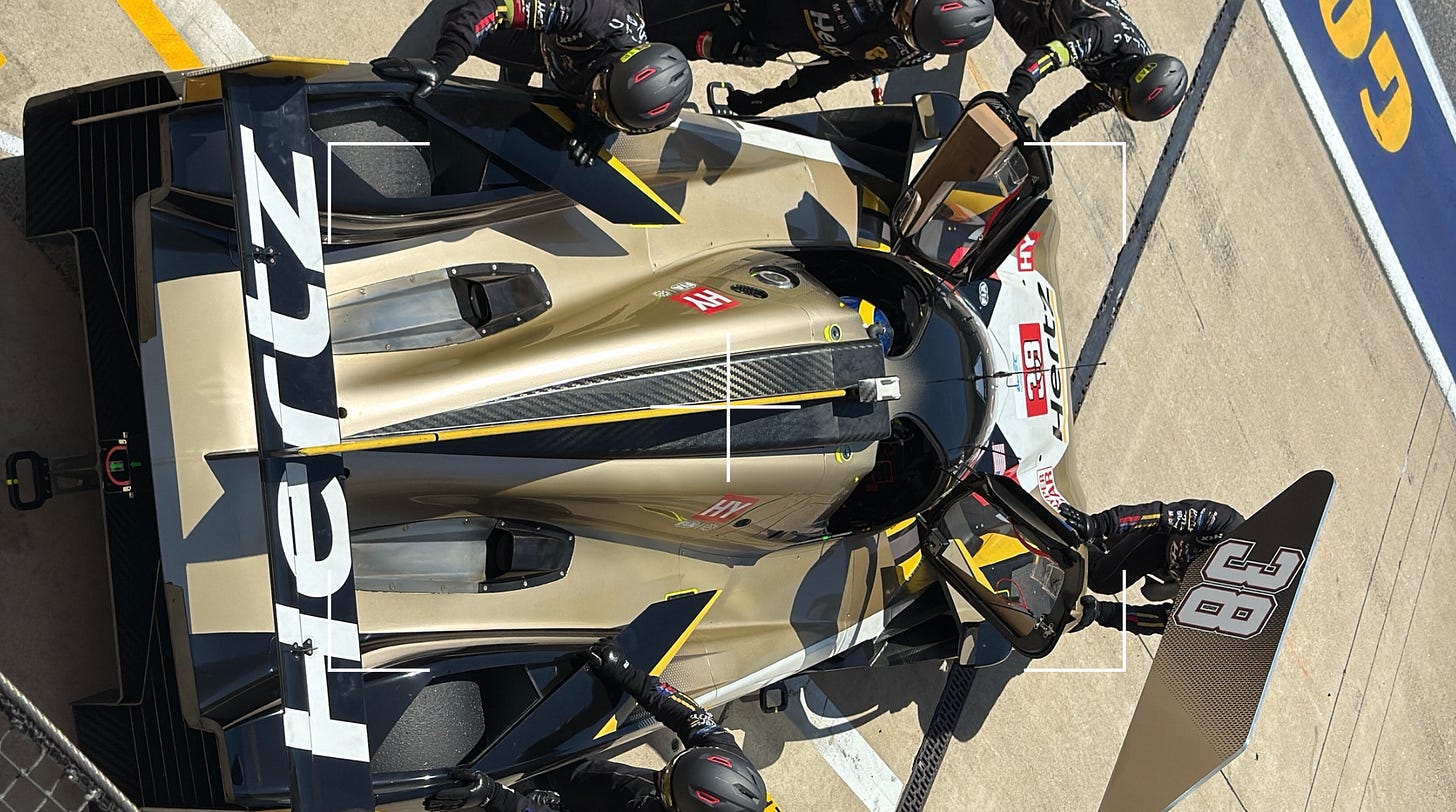WEC is having a moment
The resurgence of endurance racing you don't want to miss out on.
Thank you for being here. You are receiving this email because you subscribed to Idée Fixe, the newsletter for curious minds. I’m Toni Cowan-Brown, a tech and F1 commentator. I’ve spent the past five years on the floor of way too many F1, FE, and WEC team garages, learning about the business, politics, and tech of motorsports. I hope you’ll stick around.
⏳ Reading time: 10 minutes
Pierre Fillon, president of the Automobile Club de l’Ouest (ACO), dubbed WEC’s current period a “second golden age” of sports car racing, comparing it to the heyday of the 1980s. WEC CEO Frédéric Lequien has frequently emphasised the championship’s strong health: “Each of the last few years, the WEC has grown into one of the most prestigious motorsport championships,” he noted, citing the influx of manufacturers and a truly global calendar.
Drivers echo this enthusiasm. After winning Le Mans, Ferrari’s Antonio Giovinazzi (an ex-F1 driver) explained how he was “blown away” by the crowd energy and the realisation that “so many fans were watching worldwide”. Hypercar drivers have remarked that 2023–24 felt like a turning point – André Lotterer, a veteran who raced in the thin LMP1 grids of the late 2010s and now in the packed Hypercar field, remarked that “it’s night and day - the competition, the fans, the hype - we’re in a new era.”
The paddock consensus is that endurance racing is back in the spotlight, but WEC’s resurgence is not happening in isolation – it both benefits from and contributes to the wider motorsports ecosystem. F1’s boom created new racing enthusiasts, some of whom WEC has captured. And this is exactly what I want to talk about today, especially after attending my second 6-hour WEC race in Austin (in 2024 and 2025) and my first 24 Hours of Le Mans back in June of this year.
Attendance rebound and record crowds
The World Endurance Championship (WEC) has seen a dramatic rebound in on-site attendance since the pandemic. After limited spectators in 2020–21, fans have returned in record numbers. The 2023 24 Hours of Le Mans – the centenary edition – drew 325,000 spectators over race week, a modern-era high (up from ~244,000 in 2022 when restrictions eased). In 2024, Le Mans attendance grew further to 329,000. Other key races also hit new peaks. At Spa-Francorchamps, the WEC’s 6 Hours of Spa welcomed 72,000 fans in 2023, then 88,180 in 2024, and now 98,874 in 2025. These figures underscore a robust post-COVID attendance surge, with fans flocking back to endurance racing at levels that rival - and in some cases surpass - pre-pandemic highs.
This turnout is especially notable given endurance racing’s long events, anywhere from six to 24 hours. Fans are embracing the festival atmosphere at these races, from camping at Le Mans to trackside parties at Sebring. WEC organisers have invested in the fan experience (e.g. open paddocks, support races, concerts), and have done a phenomenal job at making events more accessible than the increasingly pricey Formula 1 weekends.
Surging viewership and media reach
This era has also delivered strong viewership gains for WEC. The 2023 Le Mans 24 Hours reached a global TV audience of 113 million – a 150% increase over the prior year. The 2023 spike was in large part driven by the race’s historic significance (100th anniversary and Ferrari’s return to top-class competition) and novel storylines. Notably, the U.S. audience for Le Mans soared making the U.S. the second-biggest market after France. Credit high-profile crossover attractions: NASCAR’s special “Garage 56” entry (with stock-car star Jimmie Johnson and F1 champion Jenson Button driving a Chevrolet Camaro) drew NASCAR and F1 fans’ curiosity, and celebrity involvement (basketball icon LeBron James served as 2023 race starter) boosted media buzz. They’ve been on an upward trajectory ever since, and don’t seem to be slowing down any time soon.
While endurance races don’t match F1’s week-in, week-out averages, the cumulative audience for WEC events is climbing. For example, WEC’s own streaming platform and online coverage have expanded accessibility, and highlights now reach millions via social media clips. In many regions, WEC has also secured new or improved broadcast deals post-COVID.
Social media and fan engagement growth
Underpinning WEC’s resurgence is a shift in fan behaviour and expectations. Today’s motorsport fans show a greater willingness to explore series beyond F1, especially when a series offers something unique. WEC’s digital footprint has grown in parallel with its on-track revival. The series’ official social media accounts have reached record followings, signalling deeper fan engagement worldwide. As of September 2025, the FIA WEC’s Instagram account surpassed 1.2 million followers - a milestone reflecting a surge in younger and global fans (for comparison, that’s roughly double its follower count from just a few years prior). Fans are not only watching races but actively following the championship year-round, albeit from their phones.
To capitalise on this momentum, WEC is investing in original content. In late 2024, the series announced a new documentary series called “Meet the Legends” – an eight-part docuseries focused on the major manufacturers in the Hypercar class (free on YouTube). The aim is to hook new audiences with storytelling. The championship’s online community is more vibrant than ever, helping convert casual viewers into dedicated fans.
Manufacturer boom and team investment trends
Perhaps the clearest sign of WEC’s revival is the flood of manufacturers (OEMs) committing to endurance racing’s top class. Following a lull in the late 2010s, the introduction of new Hypercar rules (LMH and LMDh) has ignited a renaissance. In 2023, WEC’s Hypercar grid featured 13 full-factory entries, up from just six the year before. For 2024, it expanded to 19 Hypercars – a 46% jump in one year – with newcomers like BMW and Lamborghini joining.
And the pipeline continues: McLaren has confirmed it will enter WEC’s top category in 2027, aiming to win Le Mans for the first time since 1995. Ford likewise announced a factory Hypercar programme for 2027, aligning with its long-term Le Mans ambitions. Meanwhile, Hyundai’s Genesis luxury brand will debut in 2026 - Genesis Magma Racing is already running LMP2 cars as a “training year” before fielding a Hypercar backed by Hyundai Motorsport. These future entrants join a who’s-who of automotive giants already in the game: Ferrari returned in 2023 with a victorious programme (and promptly won Le Mans on its first try), Porsche returned (although there are rumours their days in WEC may be numbered), Peugeot rejoined, Cadillac entered its first WEC season, and Aston Martin raced the Valkyrie Hypercar at Le Mans this year. In short, endurance racing now boasts an array of manufacturers not seen since the 1980s/90s, firmly re-establishing the WEC as a manufacturers’ battleground.
The economic model differs from Formula 1: WEC teams don’t enjoy massive prize funds or franchise value, so “profitability” isn’t the primary goal – factory WEC programmes are typically marketing and R&D ventures for their manufacturers, as I recently learned with Cadillac. But the return on investment is attractive: a WEC Hypercar programme costs a fraction of an F1 effort yet delivers global exposure (Le Mans victory is hugely prestigious) and technology development relevant to road cars (hybrid systems, sustainable fuels, etc.).
By contrast, F1 teams have become big businesses in their own right – the average F1 team is now valued at $1.88 billion (a 276% increase in value over just a few years), and thanks to cost caps, many are now turning annual profits. WEC teams aren’t trading at billion-dollar valuations, but manufacturers see strategic value in joining the WEC. As Zak Brown (McLaren Racing CEO) remarked, “look at the field – it’s amazing with all the manufacturers, the drivers, the competition… This is a very exciting time in endurance racing”.
Comparison to Formula 1, MotoGP, IndyCar, and Formula E
WEC’s recent trajectory both mirrors and diverges from trends in other major motorsport series. Let’s do a quick comparison:
F1’s surge (sparked by Netflix’s Drive to Survive, fueled by social media, and new races in the U.S. and the Middle East) has made Grand Prix tickets scarce and expensive; yet fans still pack circuits, with most 2024 events exceeding 300k attendees over the weekend. By comparison, WEC’s total season attendance with Le Mans alone contributing over 300k. However, WEC is closing the gap in certain areas: its marquee event attendance rivals the biggest F1 weekends, and its TV reach for Le Mans (113 million globally) even approached that of a Formula 1 race - indicating that, for one weekend at least, endurance racing commanded worldwide attention on par with top-tier single-seaters.
In terms of fan demographics and behaviour, F1’s boom has had spillover effects. New motorsport fans drawn in by F1’s drama are now sampling other series, creating a crossover audience that benefits WEC. For instance, many Ferrari F1 fans tuned in to watch Ferrari’s return to Le Mans glory. Anecdotally, endurance racing forums have noted an influx of curious F1 followers. Some F1 devotees, priced out of Grand Prix tickets or seeking a more relaxed viewing experience, have turned to WEC events as an accessible alternative.
Looking at MotoGP, the premier motorcycle championship experienced a post-COVID fan trend somewhat akin to WEC’s. After pandemic lows, MotoGP’s total 2023 attendance rebounded to 2.86 million (up ~18% from 2.43M in 2022). Like WEC, MotoGP introduced new features to boost weekend engagement and give fans more on-track action for their money. Both series also share crossover stars: MotoGP legend Valentino Rossi’s move into WEC (racing in the GT class) brought many bike racing fans to endurance events for the first time. In fact, WEC officials credit Rossi’s presence and that of other celebrity drivers (like F1 champion Jenson Button) as “helping draw in the crowds and new eyeballs” in 2024.
IndyCar, on the other hand, has had modest growth domestically but struggles to capture the new global audience that F1 and WEC are engaging. The Indianapolis 500 remains a monumental draw – ~300,000 on race day – yet most other IndyCar rounds see far smaller crowds (tens of thousands). TV viewership for IndyCar in the U.S. hovers around 1 million per race, roughly on par with or slightly below F1’s U.S. TV numbers. While IndyCar’s racing is competitive, it hasn’t enjoyed a pop-culture breakout or influx of manufacturers. Interestingly, IndyCar and WEC do share some synergy: McLaren’s high-profile involvement in IndyCar (through Arrow McLaren SP team) and upcoming WEC entry suggest top motorsport organisations now see multiple series as viable platforms. Fans, too, are branching out - an F1 or IndyCar fan is more likely today to also watch the Daytona 24 or Le Mans, especially with the convergence of sports car regulations allowing IndyCar drivers to race LMDh prototypes in endurance events.
Finally, Formula E provides a cautionary counterpoint to WEC’s manufacturer success. The electric single-seater series boomed in its early years, attracting major automakers - but by 2022 it saw an exodus: Audi, BMW, and Mercedes all pulled out of Formula E. And McLaren announced that they will not be returning in 2026. This comes as F1 and WEC’s popularity explodes and as those brands re-evaluate where to invest in racing. In short, where Formula E hit a plateau in manufacturer interest, WEC is seen as the hot ticket – a remarkable reversal from five years ago.
Shifting fan behaviour and the appeal of accessibility
Another factor is accessibility. Economically, WEC offers more bang for the buck to fans attending live. A three-day general admission to Le Mans or Spa often costs a fraction of a three-day F1 ticket; it includes far more on-track action (qualifying, support races, and hour upon hour of racing) and a lot more access. Many WEC events allow free-roaming access – fans can move around the circuit, camp out, and even get close to drivers during autograph sessions or pit walks. This inclusive atmosphere harks back to earlier days of motorsport and is attracting fans who feel priced out or kept at arm’s length by other series. The family-friendly environment (kids often admitted free, open paddock days, etc.) also helps – we see generational groups at endurance races, creating a festival feeling that turns spectators into lifelong devotees.
The ability for fans to stream races or follow live timing on apps also lowers barriers – one can be an endurance racing fan without ever attending in person, yet still feel part of the action through second-screen experiences and social media chatter. Fans are the winners. The variety and vibrancy across motorsports are at a high point, with WEC’s revival playing a key role.

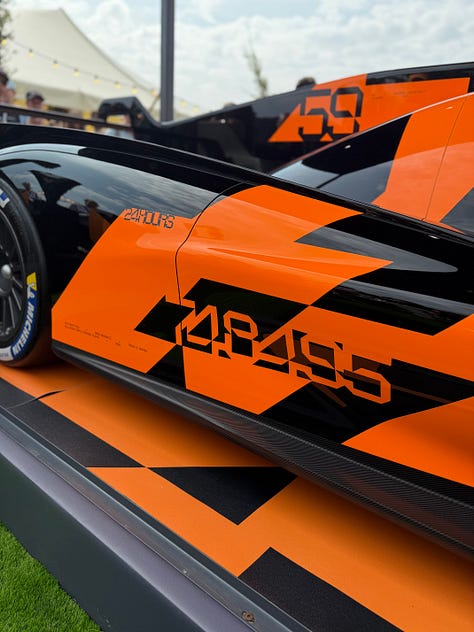
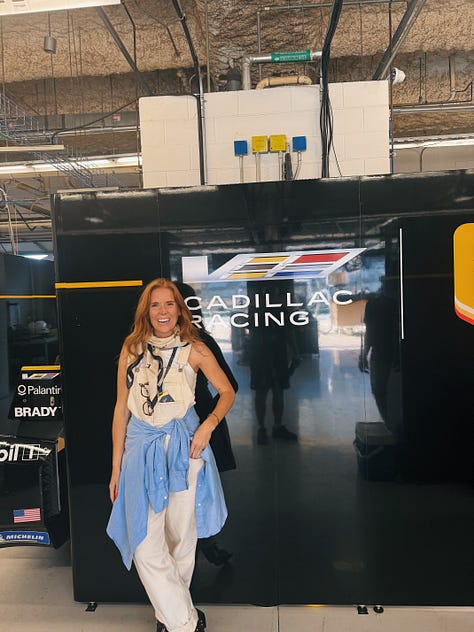

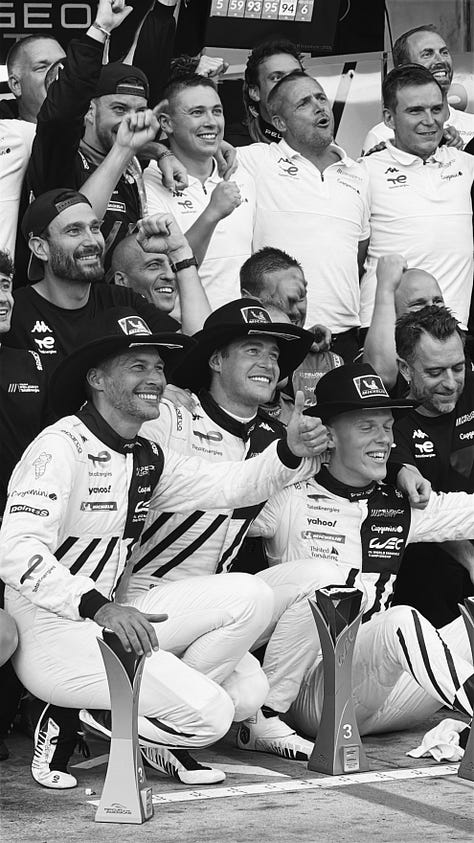
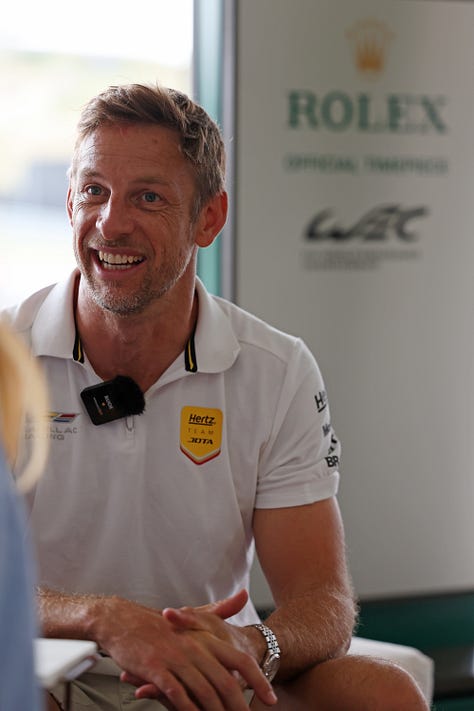

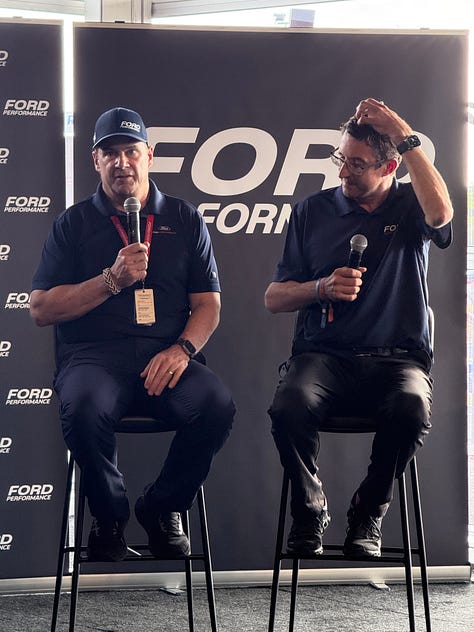

🔗 Have We Reached Peak Athlete Podcast? | Front Office Sports
By the time you finish reading this story, it’s quite possible there will be another new podcast hosted by a current or former athlete. Read here.
🔗 Max Verstappen created quite a scene with his GT3 debut at the Nordschleife | IG
”Generational brilliance” is certainly what comes to mind; just look at the crowd that gathered.
🔗 Does originality still exist anymore? | YouTube



